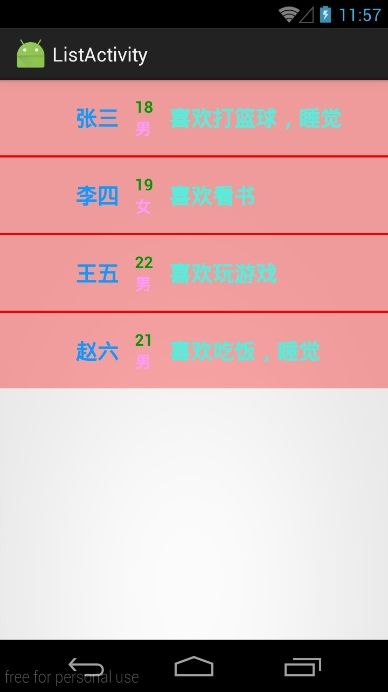Android UI设计——ListView控件与SimpleAdapter适配器(三)
SimpleAdapter
SimpleAdapter也是Android自己提供的一个Adapter适配器,它与ArrayAdapter不同的是ArrayAdapter需要使用Android自己定义的view布局文件,而SimpleAdapter则可以使用我们自己定义的布局文件。要学习SimpleAdapter的使用首先然我们看一下SimpleAdapter的构造器:

从图片中我们可以看出,SimpleAdapter只有一个构造器:
- 第一个参数
Context context是指当前的Activity,我们传入this即可。 - 第二个参数
List>是指传入的数据类型必须是List集合,集合存放的数据类型必须是Map。 - 第三个参数
int resource是指View的布局文件。也就是用来显示数据的View。 - 第四个参数
String[] from数据是以Map类型存放在List集合中的,from参数是指存放在List中每条Map数据的键值集合。 第五个参数
int[] to是指将每条Map类型的数据中的不同键值对应到不同的得布局控件中。介绍完构造器的参数,大家可能还是不太懂到底是应该如何使用,没关系,我们通过例子来说明使用。
SimpleAdapter的使用
One.定义一个ListView的布局文件。
<LinearLayout xmlns:android="http://schemas.android.com/apk/res/android"
android:layout_width="match_parent"
android:layout_height="match_parent">
<ListView
android:id="@+id/listview_array"
android:layout_width="match_parent"
android:layout_height="wrap_content"
android:cacheColorHint="#00000000"
android:divider="#f00000"
android:dividerHeight="2dp">
ListView>
LinearLayout>Two.书写一个View的布局文件,将数据以该View的形式存放在ListView中。
<LinearLayout xmlns:android="http://schemas.android.com/apk/res/android"
android:orientation="horizontal"
android:layout_width="match_parent"
android:layout_height="match_parent"
android:layout_margin="20dp"
android:gravity="center|left"
android:background="@drawable/item_background">
<ImageView
android:id="@+id/image_photo"
android:layout_width="70dp"
android:layout_height="70dp" />
<TextView
android:id="@+id/textview_name"
android:layout_width="wrap_content"
android:layout_height="wrap_content"
android:text="姓名"
android:textStyle="bold"
android:textColor="#0e99ff"
android:textSize="20sp" />
<LinearLayout
android:layout_width="wrap_content"
android:layout_height="wrap_content"
android:orientation="vertical"
android:layout_marginRight="15dp"
android:layout_marginLeft="15dp">
<TextView
android:id="@+id/textview_age"
android:layout_width="wrap_content"
android:layout_height="wrap_content"
android:text="性别"
android:textStyle="bold"
android:textColor="#009900"
android:textSize="15sp"/>
<TextView
android:id="@+id/textview_sex"
android:layout_width="wrap_content"
android:layout_height="wrap_content"
android:text="年龄"
android:textStyle="bold"
android:textColor="#ff99ff"
android:textSize="15sp" />
LinearLayout>
<TextView
android:id="@+id/textview_hobby"
android:layout_width="wrap_content"
android:layout_height="wrap_content"
android:text="爱好"
android:textStyle="bold"
android:textColor="#55eedd"
android:textSize="20sp" />
LinearLayout>Three.创建数据。创建List的集合存放Map类型的数据,并对其进行初始化。(这些直接在Activity中定义)
public HashMap createHashMap(String name, String age, String sex, String hobby){
HashMap map = new HashMap();
map.put("name", name);
map.put("age", age);
map.put("sex",sex);
map.put("hobby", hobby);
return map;
}
public void initList(){
mData = new ArrayList>();
HashMap zhangsan = createHashMap("张三", "18", "男", "喜欢打篮球,睡觉");
mData.add(zhangsan);
HashMap lisi = createHashMap("李四", "19", "女", "喜欢看书");
mData.add(lisi);
HashMap wangwu = createHashMap("王五", "22", "男", "喜欢玩游戏");
mData.add(wangwu);
HashMap zhaoliu = createHashMap("赵六", "21", "男", "喜欢吃饭,睡觉");
mData.add(zhaoliu);
} Four.在onCreate()方法中初始化数据,创建SimpleAdapter的对象
String[] from = new String[]{"name", "age", "sex", "hobby"};
int[] to = new int[]{R.id.textview_name,R.id.textview_age,R.id.textview_sex,R.id.textview_hobby};
initList();
SimpleAdapter simpleAdapter = new SimpleAdapter(this,mData,R.layout.item_simpleadapter,from,to);Five.调用setAdapter()方法,将View添加到ListView中。
mListViewArray.setAdapter(simpleAdapter);Activity整体的代码为:
public class ListActivity extends Activity {
private ListView mListViewArray;
//定义数据。
private List> mData;
@Override
protected void onCreate(Bundle savedInstanceState) {
super.onCreate(savedInstanceState);
setContentView(R.layout.activity_list);
//创建ListView的对象。
mListViewArray = (ListView) findViewById(R.id.listview_array);
//初始化数据,通过调用自己定义的初始化方法。
initList();
//创建SimpleAdapter对象,将添加到数据添加到自己定义的View中。
SimpleAdapter simpleAdapter = new SimpleAdapter(this,mData,R.layout.item_simpleadapter,
new String[]{"name", "age", "sex", "hobby"},new int[]{R.id.textview_name,R.id.textview_age,R.id.textview_sex,R.id.textview_hobby});
//将View添加到ListView中。
mListViewArray.setAdapter(simpleAdapter);
}
//定义Map类型的数据。
public HashMap createHashMap(String name, String age, String sex, String hobby){
HashMap map = new HashMap();
map.put("name", name);
map.put("age", age);
map.put("sex",sex);
map.put("hobby", hobby);
return map;
}
//对数据进行初始化的方法。
public void initList(){
mData = new ArrayList>();
HashMap zhangsan = createHashMap("张三", "18", "男", "喜欢打篮球,睡觉");
mData.add(zhangsan);
HashMap lisi = createHashMap("李四", "19", "女", "喜欢看书");
mData.add(lisi);
HashMap wangwu = createHashMap("王五", "22", "男", "喜欢玩游戏");
mData.add(wangwu);
HashMap zhaoliu = createHashMap("赵六", "21", "男", "喜欢吃饭,睡觉");
mData.add(zhaoliu);
}
} 